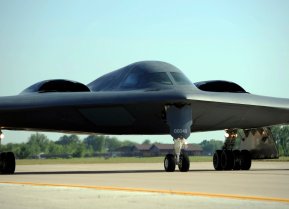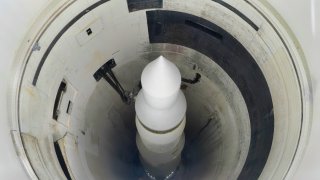The Old But Dangerous Minuteman III ICBM Could Kill Billions of People
Minuteman IIIs are hosted by three bases, located in the frozen tundra of the USAF’s so-called “Northern Tier”: Minot AFB, North Dakota, Malmstrom AFB, Montana, and F.E. Warren WFB, Wyoming.
Meet the Minuteman III: Back during the American Revolutionary War, the term Minutemen referred to a small hand-picked elite force that was required to be highly mobile and able to assemble at a moment’s notice. Minutemen were selected from militia muster rolls by their commanding officers, based upon their enthusiasm, reliability, and physical strength, typically from the age range of 25 and below. Typically, roughly 25 percent of the militia served as Minutemen, performing additional duties as such, and were the first armed militia to arrive or await a battle.
In the present day and age, the term Minuteman is a non-human machine that would be both the first and last to respond to a far different kind of war, a war that would usher in “The End of the World as We Know It” (TEOTWAWKI), i.e., World War III. Say hello to America’s LGM-30G Minuteman III intercontinental ballistic missile (ICBM).
Minuteman III History and Specifications
As noted by the official U.S. Air Force info page, “The LGM-30G Minuteman intercontinental ballistic missile, or ICBM, is an element of the nation's strategic deterrent forces under the control of the Air Force Global Strike Command. The ‘L’ in LGM is the Department of Defense designation for silo-launched; ‘G’ means surface attack; ‘M’ stands for guided missile, the 30 stands for the Minuteman series of missile and the G after ‘30’ is the current Minuteman III ... Missiles are dispersed in hardened silos to protect against attack and connected to an underground launch control center through a system of hardened cables. Launch crews, consisting of two officers, perform around-the-clock alert in the launch control center … The Minuteman weapon system was conceived in the late 1950s and Minuteman I was deployed in the early 1960s. Minuteman was a revolutionary concept and an extraordinary technical achievement.”
As for the Minuteman III variant, it had its first test launch on August 16, 1968, and was first deployed in 1970. In addition to greater length and power than the first two generations of Minuteman, the third iteration sported an improved guidance system that could be retargeted in minutes. But most significantly – especially in relation to that aforementioned TEOTWAWKI concept – was the then-revolutionary new warhead, the multiple independently targeted reentry vehicle (MIRV). The Minuteman III wields three such MIRVs.
Minuteman IIIs are hosted by three bases, located in the frozen tundra of the USAF’s so-called “Northern Tier”: Minot AFB, North Dakota, Malmstrom AFB, Montana, and F.E. Warren WFB, Wyoming.
The Minuteman III is 59.9 feet in length, 5.5 feet in diameter, and weighs 79, 432 pounds, with a range of 5,218 nautical miles and a speed of 15,000 miles per hour (Mach 23). Its General Electric MK 12 MIRV is 5.9 feet long and hosts a W62 warhead with a yield of 170 kilotons.
Matching Up Against Russian and Chinese Nukes
Alas, this all-American ICBM is no longer the proverbial biggest boy on the block.
For starters, the Russians have the R-36, which NATO has officially designated the SS-18 and unofficially nicknamed the “Satan” missile. This devilish destructive device could hit anywhere in the U.S. with at least ten 18-25 megaton MIRVs, and as of March 2022 the Russians have 46 such missiles in their arsenal.
Meanwhile, China is putting the finishing touches on its DF-41 (Dong Feng-41 / CSS-X-20), which also hosts 10 MIRVs; it has a launch weight of 80,000 kilograms, a payload of 2,500 kilos, and range of 15,000 kilometers.
My Personal Interactions with Minuteman III
The Minuteman III and I have a bit of personal history together. You see, the enlisted portion of my military career was spent as a U.S. Air Force Security Forces (HOOAH!!!) troop stationed at Minot AFB, tasked with safeguarding these very missiles. More specifically, I was an E-3/Airman 1st Class (A1C) tasked with the duties of an Alarm Response Team (ART) Leader; an ART is comprised of two Security Forces members dedicated to a restricted area to respond immediately if possible, but no longer than five minutes, to alarms or incidents.
In the discharge of my duties, I never actually got to see the missiles, but I’ll tell ya this much: responding to incidents at the topside of those Launch Facilities (LFs) whilst toting my M16A2 rifle with 180 rounds of 5.56mm M855 ball and M856 tracer ammo in a 3:1 ratio and wearing a Kevlar helmet and flak vest … knowing that most destructive weapons known to mankind were beneath my very feet, served as a sobering reminder to me of the serious nature of the business I was in, i.e. the responsibilities inherent to the profession of arms that I had freely chosen to pursue.
About the Author
Christian D. Orr is a former Air Force Security Forces officer, Federal law enforcement officer, and private military contractor (with assignments worked in Iraq, the United Arab Emirates, Kosovo, Japan, Germany, and the Pentagon). Chris holds a B.A. in International Relations from the University of Southern California (USC) and an M.A. in Intelligence Studies (concentration in Terrorism Studies) from American Military University (AMU). He has also been published in The Daily Torch and The Journal of Intelligence and Cyber Security. Last but not least, he is a Companion of the Order of the Naval Order of the United States (NOUS). In his spare time, he enjoys shooting, dining out, cigars, Irish and British pubs, travel, USC Trojans college football, and Washington DC professional sports.
Main image is from Shutterstock. All others are Creative Commons.


